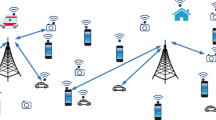Abstract
Resource allocation algorithms play the main role in provisioning high throughput in broad band wireless communications. The previous studies in WiMAX networks have considered either AMC or PUSC techniques for the resource allocation algorithms. In this way, AMC based algorithms have presented high throughput for low speed users. Conversely, PUSC based algorithms have not been affected by users’ speed, whilst the throughput is low. To date, the importance of presenting proportional fair and maintaining the network throughput for the users with different speeds has not been acknowledged yet. This paper presents a novel opportunistic algorithm which is suitable for the users with different mobility speeds. The new algorithm uses two modes of AMC and PUSC simultaneously. The simulation results reveal that in comparison to similar algorithms, the proposed algorithm presents more proportional fair throughput when there are both high and low speed users.









Similar content being viewed by others
References
IEEE 802.16j. (2007). Draft IEEE Standard for local and metropolitan area networks—Part 16: Air interface for fix and mobile broadband wireless access systems.
Dhrona, P., Abu Ali, N., & Hassanein, H. (Oct. 2008). A performance study of scheduling algorithms in point-to-multipoint WiMAX networks. In The proceeding of the 33rd IEEE conference on local computer networks (LCN) (pp. 843–850).
Can, B., Yanikomeroglu, H., Onat, F. A., De Carvalho, E., & Yomo, H. (2008). Efficient cooperative diversity schemes and radio resource allocation for IEEE 802.16j. In Proceedings of IEEE conferance wireless communications and networking (WCNC) (pp. 36–41).
Kalyani, S. (2012). Analysis of opportunistic scheduling algorithms in OFDMA systems in the presence of generalized fading models. Wireless Communications, 2996–3005.
Deb, S., Mhatre, V., & Ramaiyan, V. (2008). WiMAX relay networks: Opportunistic scheduling to exploit multiuser diversity and frequency selectivity. In Proceedings of the 14th ACM international conference on mobile computing and networking (MobiCom ’08) (pp. 163–174).
Narasimha, S., & Sivalingam, K.M., (2009). Improved opportunistic scheduling algorithms for WiMAX mobile multihop relay networks. In International conference on high performance computing (HiPC) (pp. 20–29).
Cicconetti, C., Erta, A., Lenzini, L., & Mingozzi, E. (2007). Performance evaluation of the IEEE 802.16 MAC for QoS support. In Proceeding of IEEE transactions on mobile computing (pp. 26–38).
Ruangchaijatupon, N., Wang, L., & Ji, Y. (2006). A study on the performance of scheduling schemes for broadband wireless access networks. In Proceeding of international symposium on communications and information technology (pp. 1008–1012).
Vinay, K., Sreenivasulu, N., Jayaram, D., & Das, D. (2006). Performance evaluation of end-to-end delay by hybrid scheduling algorithm for QoS in IEEE 802.16 network. In Proceeding of international conference on wireless and optical communication networks (p. 5).
Jianfeng, S., Jiandong, L., & Changle, L. (2009). A cross-layer WiMAX scheduling algorithm based on genetic algorithm. In Communication networks and services research conference (pp. 292–296).
Zhul, X., Huo, J., Zhaol, S., Zeng, Z., & Ding, W. (2008). An adaptive resource allocation scheme in OFDMA based multiservice WiMAX systemis. In Proceeding of the 10th IEEE international on advanced communication technology (ICACT) (pp. 593–597).
Gholipur, T., & Mahdavi, M. (2013). A novel scheduling algorithm for low and high mobility users in multi-hop WiMAX network. Journal of Wireless Personal Communications, 72(2), 1203–1228.
Navidy, N. N., Sedghi, R., & Tah, R.H. (2012). A new approach for WiMAX multi-hop network & token bucket packet scheduling algorithm. In 2nd International conference on communications and networks (CECNet) (pp. 804–807).
Rapaport, T. (2002). Wireless communications principle and practice (2 ed.). New York: Goodwin, B.
Chang, C. J., Yen, C. M., Ren, F. C., & Chuang, C. H. (2008). QoS\_GTE: A centralized QoS guaranteed throughput enhancement scheduling scheme for relay-assisted WiMAX networks. In Proceedings of IEEE international conference on communications (ICC) (pp. 3863–3867).
Zeng, H., & Zhu, C., (2009). Resource allocation in 802.16j multi-hop relay systems with the user resource fairness constraint. In WCNC’09 IEEE conference.
Sulyman, A. I. (2010). Using threshold-based PUSC for throughput enhancement in WiMAX OFDMA local computer networks (LCN). In IEEE 35th conference on digital object identifier (pp. 749–751).
Riato, N., Sorrentino, S., Franco, D., Masseroni, C., Rastelli, M., & Trivisonno, R. (2007). Impact of mobility on physical and MAC layer algorithms performance in WiMAX system. In Proceeding of the 61st IEEE international symposium on personal, indoor and mobile radio communications (pp. 1–6).
Mills, A., Lister, D., De Vos, M., & Yusheng, J. (2010). The impact of MS velocity on the performanc of frequency selective scheduling in IEEE 802.16e mobile WiMAX. In Proceeding of the 7th IEEE conference on consume communications and networking (CCNC) (pp. 1–5).
Adas, A. M. (1998). Using adaptive linear prediction to support real-time VBR video under RCBR network service model. IEEE/ACM Transactions on Networking, 6(5), 635–644.
Liu, O., Wang, X., & Giannakis, G. B. (2005). Cross-layer scheduler design with QoS support in wireless access networks. In Proceedings of international conference on quality of service in heterogeneous wired/wireless networks (pp. 13–21).
Wimax Forum. (May 2007). WiMAX forum mobile system profile 4 release 1.0 approved specification.
Baum, D. S., Hansen, J., Salo, J., & Galdo, J. (2005). An interim channel model for beyond-3G systems: Extending the 3GPP spatial channel model (SCM). In Proceeding of the 61st IEEE international conference on vehicular technology (Vol. 5, pp. 3132–3136).
Wang, L. C., Su, W. S., Huang, J. H., Chen, A., & Chang, J. H. (2008). Optimal relay location in multi-hop cellular systems. In Proceedings of IEEE conference wireless communications and networking (WCNC) (pp. 1306–1310).
Author information
Authors and Affiliations
Corresponding author
Rights and permissions
About this article
Cite this article
Gholipur, T., Mahdavi, M. & Zeidaabadi Nezhad, A. Multi-Hop WiMAX Networks: A New Opportunistic Algorithm Using AMC and PUSC Mode for Different Mobility Users. Wireless Pers Commun 75, 1547–1571 (2014). https://doi.org/10.1007/s11277-013-1437-9
Published:
Issue Date:
DOI: https://doi.org/10.1007/s11277-013-1437-9




